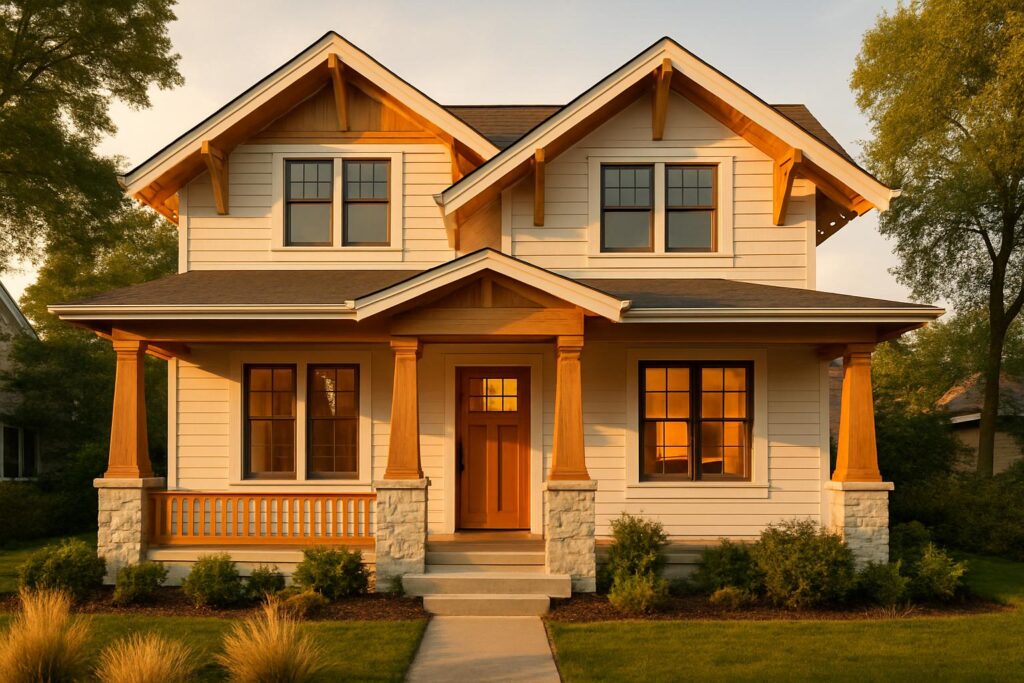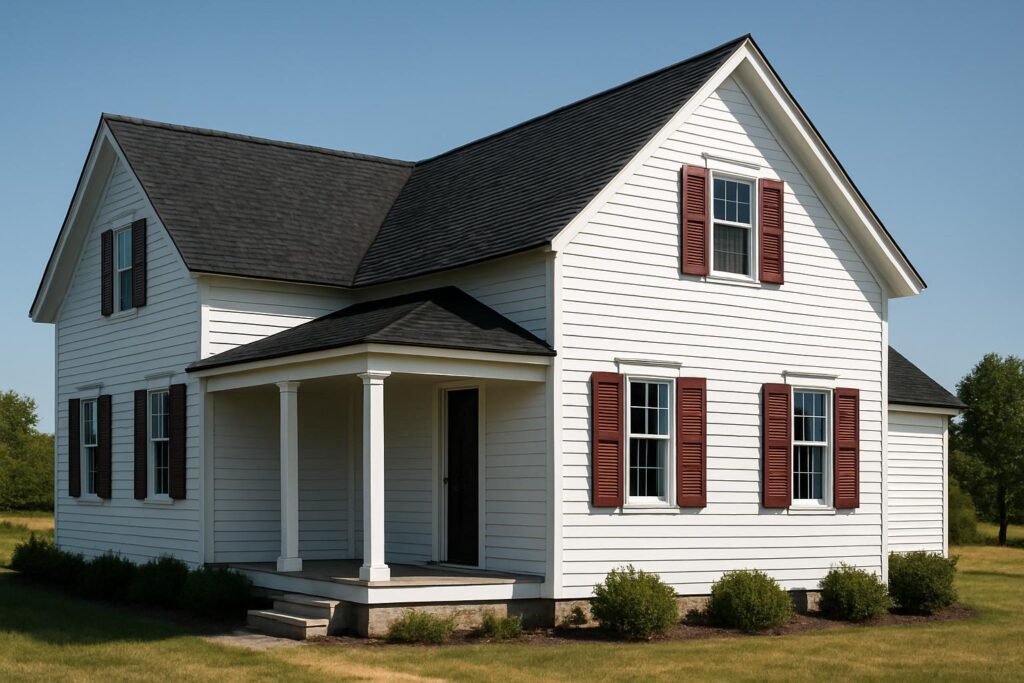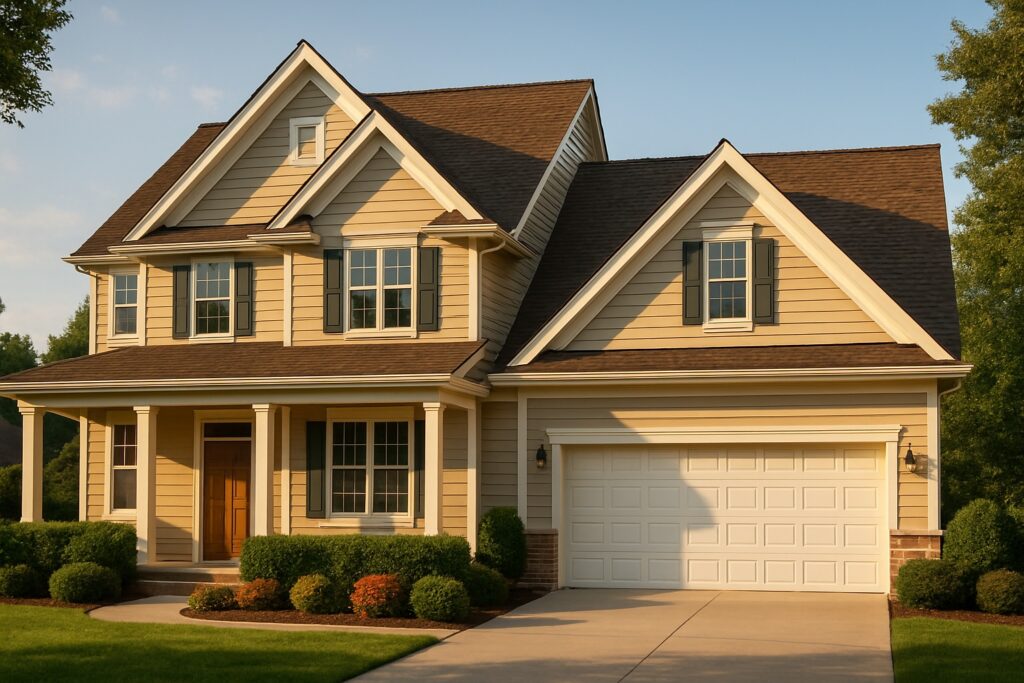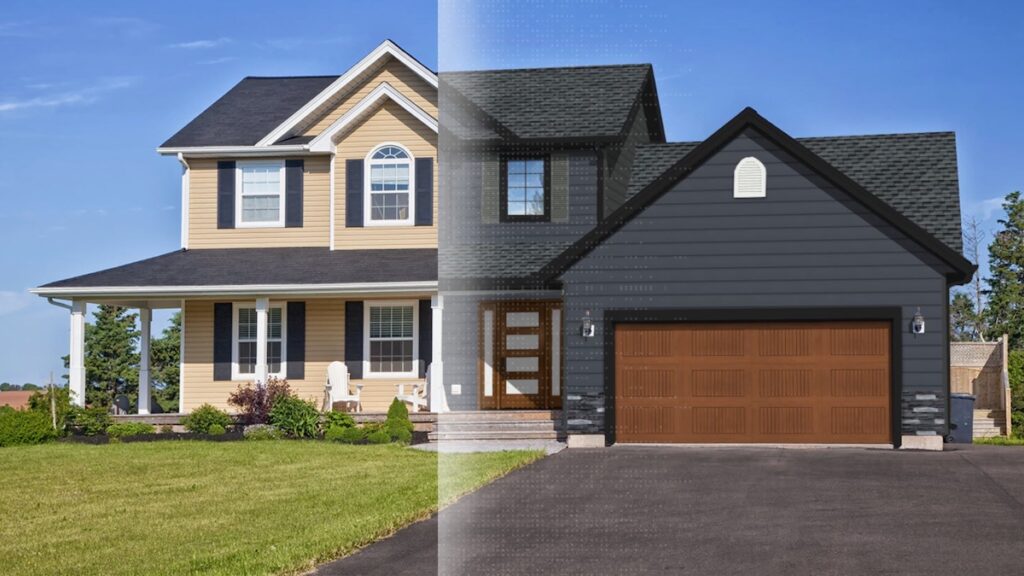TLDR
Finding the right brick color can completely transform your home exterior—both in curb appeal and long-term value. Here’s what to keep in mind:
Match your brick color with roof, trim, mortar, and front door for a cohesive palette.
Use contrast and undertone alignment to make architectural details pop.
Explore paint, stain, and limewash for different textures and maintenance levels.
Consider regional trends, climate, and architectural style before finalizing colors.
Preview your ideas on your actual home using a visualization tool to avoid costly mistakes.
The right strategy ensures your brick home looks timeless, functions beautifully, and delivers lasting ROI—something Renoworks Pro can help you visualize before you commit.

Introduction
A great façade starts with smart color decisions. The right brick and supporting tones can modernize an older brick house, calm a busy street view, or make a smaller brick home appear larger—without losing the character that made you love it in the first place. Use this guide to choose a brick color with confidence, avoid costly mistakes, and preview options before you ever pick up a brush.
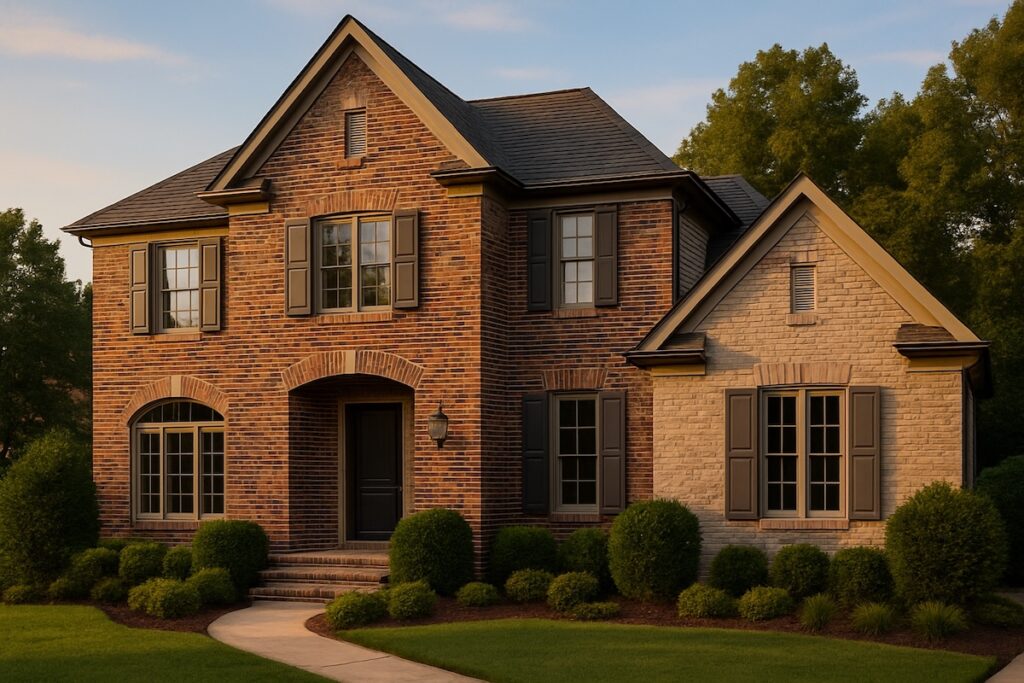
What “Timeless” Really Means for a Brick Home
Timeless doesn’t mean plain. It’s harmony—tones that feel at home with your architecture, neighborhood, roof, and landscape. Think classic pairings that have looked good for decades, with just enough contrast to keep things crisp. If you’re aiming for longevity, pair light brick with white trim, balance a neutral roof with a bold front door, and let architectural style lead the way.
Pro Tips for Timeless Appeal:
Keep three finishes in balance: field (brick and stone), trim color, and accents.
Use contrast intentionally—light brick with a dark gray roof, or dark brick with lighter tones.
Coordinate undertone between paint color, mortar, and roof to ensure cohesion.
Popular Brick Color Categories & How They Shape a Home’s Look
Choosing a brick color is more than a design decision—it’s the backbone of your home’s curb appeal. Each shade, from warm red brick to deep black brick, brings its own personality and changes how the rest of your exterior feels. The right choice can highlight your architectural style, balance proportions, and create a sense of harmony with your roof, trim, and landscape. Below, you’ll find the most popular brick color categories, complete with design notes and pairing ideas, so you can see exactly how each one shapes the look and feel of a home.
Red Brick
Warm, welcoming, and never out of place. Red brick loves calm beige or white paint trim and a confident entry. A black shutter or charcoal front door can add modern edge without overpowering the palette.
Works well with: neutral landscaping, tone-consistent roofing, and warm lighting.
Gray Brick
Modern but adaptable. Gray brick works with white trim for clarity or with kendall charcoal for depth. Add a tan front door to soften the look, and consider a bold roof color for extra personality.
White Brick
Fresh and airy, white brick can make a home exterior look larger and cleaner. Maintain some texture so it doesn’t go flat. Pair with a dark roof, black accents, or a wood door to add warmth.
Brown Brick
Cozy and grounded, brown brick pairs beautifully with tan trim color, natural stone, and neutral tones. Works especially well in wooded settings with earthy textures.
Black Brick
Dramatic and architectural. Black brick thrives when paired with light brick accents, white trim, and bold front doors in sherwin williams colors. A dark gray roof can complete the look.
How to Choose Colors With Confidence
Choosing the right brick color and exterior paint color begins with a clear plan. Look at the entire brick home—roof, mortar, trim color, and front door—and align shades so they work together. Use contrast to emphasize features, match undertone for a cohesive palette, and test options directly on the facade. These simple steps keep the home exterior balanced, attractive, and timeless.
Start with Fixed Elements
The brick house itself, the roof, and mortar lines set the foundation. Matching your palette to these fixed features keeps the style cohesive and the design authentic.
Read the Surroundings
Natural light, shade from trees, and the undertone of nearby homes all affect color perception. Step back across the street to see your brick home in context.
Balance Contrast and Cohesion
High contrast between exterior paint color and trim feels modern; low contrast feels calm and classic. Use contrast to control where the eye goes—often toward the front door.
Test Before You Commit
Sample larger than you think—especially on brick and stone. View each paint color in morning, afternoon, and evening light to see undertone shifts.
HOME VISUALIZER TOOL
Still Imagining? Start Designing.
Visualize your home — for free. Instantly explore siding styles, colors, and renovations with just one photo. No forms. No pressure. Just results.

Paint, Stain, and Limewash: Which Finish Fits Your Goals?
Updating a brick home isn’t just about picking a new brick color—it’s about choosing the right finish for your goals. Paint brick for a uniform exterior paint color, stain to shift undertone while keeping texture, or use limewash for a softer, timeless facade. Each option interacts differently with mortar, trim color, and the overall palette, so matching the finish to your style and maintenance needs is key.
Paint
Paint brick for a uniform, modern finish and maximum control over color. Prep by cleaning mortar joints and using breathable coatings.
Stain
A great way to alter tone without hiding brick texture. Thin brick veneers respond well to stain, maintaining depth and variation.
Limewash
Soft and timeless. White paint limewash can be partially washed back to show texture while muting strong undertones.
Color Strategy for Real Homes
Creating the right color strategy for a brick home means thinking beyond the brick color itself. Start by matching the roof to the overall palette, then coordinate trim color, front door, and mortar for balance. Use contrast to highlight architectural features, ensure undertone alignment for cohesion, and work texture into the facade for depth. This approach keeps the home exterior visually strong and timeless in any setting.
Match to Your Roof First
A roof is a dominant exterior element. Align its tone with your brick color and palette to keep the whole home exterior cohesive.
Trim is Your Focus Tool
White trim makes a brick house look sharper and more defined, while darker trim color blends edges for a softer facade.
Put Emphasis Where It Counts
A front door in a bold paint color adds instant curb appeal. For extra depth, pair a dark shade with lighter trim.
Use Texture as a Design Element
Brick and stone have natural shade variations—play them up with contrast in roof, trim, and landscape.
Palette Recipes
The right palette can completely redefine a brick home, whether you’re working with red brick, gray brick, white brick, brown brick, or black brick. By aligning brick color with roof, trim color, front door, and mortar tone, you create an exterior paint color scheme that feels intentional and balanced. These palette ideas show how different combinations—neutral tones, bold contrasts, and cohesive undertones—can transform a facade while keeping the home exterior timeless.
For Red Brick
Off-white trim color, dark gray roof, bold front door
Landscape with neutral shrubs and plants to balance tone
For Gray Brick
White trim, black shutter accents, and sherwin williams front door colors
Texture-rich facade elements for warmth
For White Brick
Beige trim, wood front door, dark roof
Black accents for contrast
For Brown Brick
Tan trim color, neutral palette, coordinated roof and mortar
Bold front door for personality
For Black Brick
White paint trim, kendall charcoal door, balanced exterior paint color palette
Landscape lighting to highlight texture
Before & After Inspiration
Picture an aging brick house with mismatched roof and faded trim color. After painting brick in a cohesive palette, aligning roof tone, refreshing mortar, and upgrading the front door, the home exterior feels brand new.
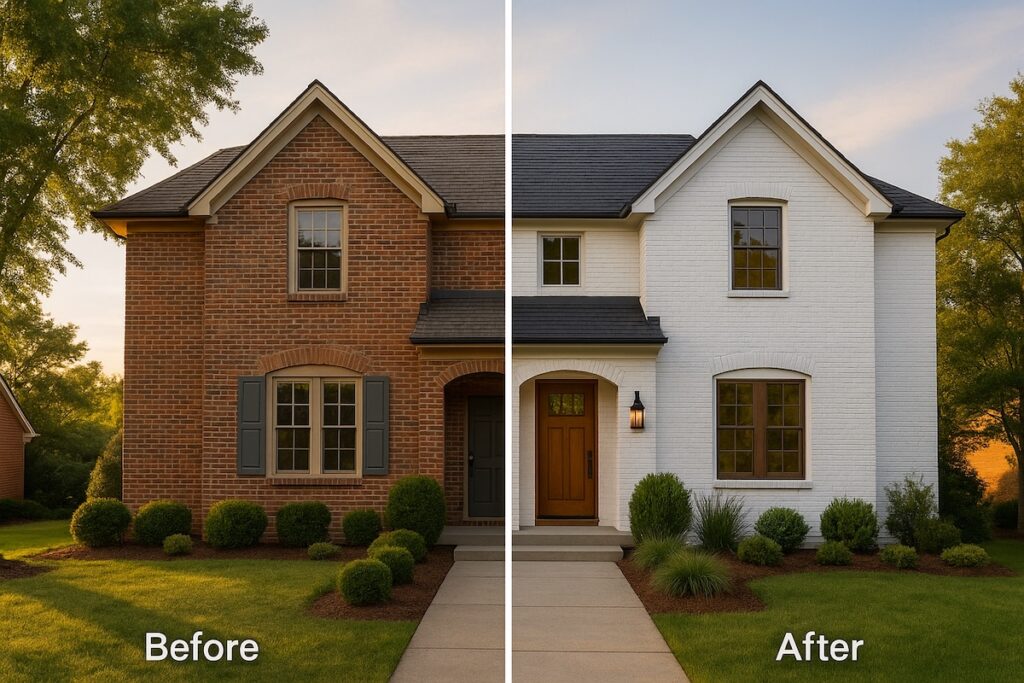
Mortar Matters
Mortar color shifts how every brick home reads. Light mortar makes red brick pop; dark mortar deepens gray brick. If you change mortar color, consider its undertone in your palette.
Maintenance Tip: Keep mortar in good shape to protect the facade and maintain curb appeal.
Regional & Architectural Notes
Brick color isn’t just about style—it’s influenced by climate, regional trends, and architectural design. A brick home in a warm, sunny climate might benefit from lighter exterior paint colors that reduce heat absorption, while homes in cooler regions can embrace deeper tones for warmth and character. Traditional styles often favor red brick and classic mortar, while modern architecture leans into gray brick, black brick, and high-contrast trim color. Understanding these regional and architectural cues ensures your home exterior feels authentic to its setting while still reflecting your personal style.
Architecture First
Colonial, Tudor, Modern Farmhouse, or Ranch—each style has brick color combinations that feel authentic. Match your exterior paint color palette to the architecture’s tone.
Climate Counts
Snow reflects white, making dark brick stand out more. In sunny climates, light brick helps keep a home exterior cooler.
Neighborhood Cues
Blend with context without disappearing. Brick and stone combinations can be bold but should respect the surrounding style.
Maintenance, Longevity, and ROI
Maintaining your brick house means cleaning mortar, refreshing paint color, inspecting the roof, and protecting the front door finish. These small steps keep your home exterior looking great and your style investment intact.
Bringing It All Together
A well-chosen brick color and finish can define your home exterior for decades, but the real value comes from pairing smart design choices with consistent upkeep. From matching your palette to the architecture and climate, to maintaining mortar and trim color, each decision adds to your home’s curb appeal and long-term ROI. With the right strategy, your brick home becomes more than a structure—it’s a lasting investment in beauty, function, and style.
Your Next Step: Preview your brick color ideas in a visualization tool before committing. Seeing a palette on your actual brick home can save time, money, and second-guessing.
FAQ
1. What brick color works best with my home exterior style?
The right brick color depends on your architectural style, roof tone, and trim color. Colonial homes often favor red brick with white trim, modern designs lean into gray brick or black brick, and farmhouse styles work well with white brick or brown brick. Always match undertone across the palette for a cohesive look.
2. Should I paint brick or keep it natural?
Paint brick for a uniform exterior paint color and a fresh style, stain if you want to shift undertone while keeping texture, or limewash for a softer, aged facade. Each option interacts differently with mortar, trim color, and roof, so consider maintenance needs and long-term ROI before deciding.
3. How can I make my brick house look bigger?
Light brick or white paint can visually enlarge a facade, especially when paired with high-contrast trim color and a defined front door. Keeping landscaping low and clean also makes the home exterior appear larger and more open.
4. What’s the most timeless brick color?
Neutral tones like red brick, white brick, and light gray brick have remained popular for decades. They work with a wide range of roof colors, trim colors, and front door finishes, making them easy to update without a full repaint.
5. How do climate and region affect brick color choices?
In sunny, hot regions, lighter brick colors help reduce heat absorption, while darker brick shades add warmth in colder climates. Local style trends also matter—regional architecture often pairs certain brick and stone combinations, mortar colors, and palettes for authenticity.


